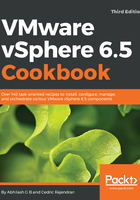
上QQ阅读APP看书,第一时间看更新
How to do it...
The following procedure will guide you through the steps involved in deploying VCSA 6.5 with an embedded PSC:
- Map and browse the contents of the VCSA ISO ROM, navigate to vcsa-ui-installer, and choose a subdirectory corresponding to your operating system (lin64, mac, win32). In this case, we will navigate to the win32 directory and run the executable installer.exe as an administrator to bring up the vCenter Server Appliance 6.5 Installer window:

- On the vCenter Server Appliance 6.5 Installer window, click Install to bring up the Install - Stage 1: Deploy Appliance window. Click Next to continue:
- Accept the EULA and click Next to continue.
- Choose a deployment type. In this case, we are deploying a vCenter Server with an Embedded Platform Services Controller.
- The same installation wizard can be used to deploy external PSCs and vCenter Servers without PSCs as well. Click Next to continue.
- On the Appliance deployment target screen, supply the IP address/FQDN and the credentials of the vCenter or the ESXi host the appliance VM will be deployed onto. In this case, the target is an ESXi host. Click Next to continue:

- Click on Yes to accept the target host's SSL certificate.
- On the Setup appliance VM screen, supply a name for the VM and set the password for its root user. Click Next to continue.
- Select an intended deployment size and click Next to continue:

- Select a datastore to place the appliance VM in. You can perform the Thin provisioning (TP) on the VMDKs if you choose to, by selecting Enable Thin Disk Mode. Click Next to continue:

- On the Configure network settings screen, supply a System name (which can either be the IP address or FQDN for the appliance) and the IP configuration. Click Next to continue:

If you do not specify a System name, then the IP address will be used as the actual system name. The system name will be used in the SSL certificates of the appliance VM.
- On the Ready to complete stage 1 screen, review the settings and click Finish to deploy the appliance.
- Once the deployment completes successfully, you will be presented with a screen indicating deployment is complete. Click Continue to start the stage 2 installer wizard.
If you accidentally close the wizard or choose to continue at a later time, then the stage 2 installer can be started by connecting to the appliance administration URL: https://VCSA IP or FQDN:5480 and using the Set up vCenter Server Appliance option.
- On the Install - Stage 2: Set Up vCenter Server Appliance with an Embedded PSC screen, click Next to continue.
- On the Appliance configuration page, the IP configuration will be pre-populated. However, you will need to decide on the Time synchronization mode. You can either choose to synchronize time with the ESXi host or use NTP servers. It is recommended to time synchronize all your vSphere components with an NTP server. Supply the NTP servers IP address(s) and click Next to continue:

- On the SSO configuration screen, supply an SSO domain name (the default is vsphere.local), set the password for the SSO administrator, and add a Site name:

Using vsphere.local as the SSO domain name is perfectly fine, unless you want to change it. Changing the default SSO domain name is only possible with vSphere 6.0 and above.
- On the Configure CIEP screen, choose whether or not to join the Customer Experience Improvement Program (CEIP) and click Next to continue.
- On the Ready to complete screen, review the settings and click Finish to initiate the configuration of services in the appliance.
- Once the appliance setup is complete, you will be presented with a screen indicating this. Click Close to exit the wizard.
You should now be able to connect to the vCenter Server using the vSphere Web Client URL provided in the previous screen. URL https://FQDN or IP of the appliance:443/vsphere-client/.